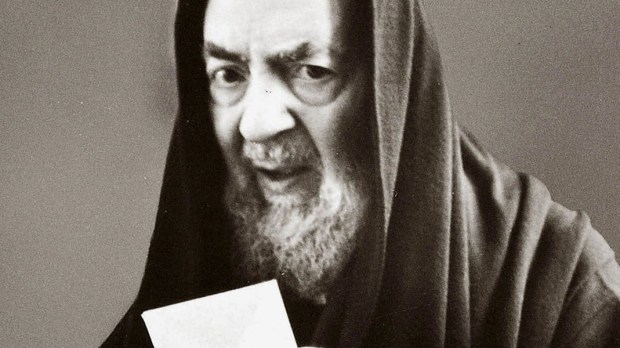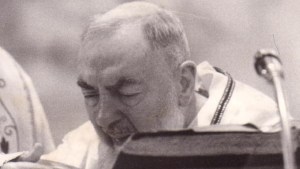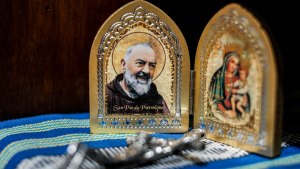Padre Pio had a very important epistolary relationship with one of his spiritual daughters — Raffaelina Cerase. The relationship between Padre Pio and the woman from Foggia (who repeatedly called herself a “hardened sinner,” and sought – and obtained – at all costs spiritual meetings with the friar of Pietrelcina) has been used by some critics to put the saint’s virtue in question, but the reality is quite the opposite.
Italian authors Fr. Marcello Stanzione and Francesco Guarino, in a book about the saint and the sinner (Padre Pio e Raffaelina Cerase, currently only available in Italian), give the exact chronology of the epistolary relationship between the two, which attests to Raffaelina’s path of inner growth, divorced from any other (non-spiritual) reference to the then-young Padre Pio.
Raffaelina Cerase – known among her close family by her nickname, Lellina – was an Italian noblewoman who lived in the late 19th and early 20th centuries (1868-1915). She was born in Foggia, a city in southern Italy, to a family of landowners. Fr. Benedetto Nardella, in his biographical booklet on the noblewoman, calls her birth “the dawn of an angel.”
In the care of her aunt, a nun
Raffaelina was entrusted to the spiritual care of her aunt, a nun who resided at the Carmelite convent in Lucera, where the girl remained until the age of 7 before diving – as she herself would write in her correspondence with Father Pio – completely into worldly life, becoming what she called “blind, deaf, and wicked.”
Conversion
Lellina’s conversion took place at the age of 21, in 1889. The example of her aunt who died with a reputation of sanctity, however, would be an example for her that would leave an indelible mark on the trajectory of her life.
Family division
One mournful event seems to have been decisive in her life: the death of her father in 1904. Upon the death of her father, a whole series of disagreements began with her brother Matteo for reasons that led her, together with her sister Giovina, to move away from her father’s house and to live for seven years, from 1907 to 1914, in “exile,” as she herself says, in a rented house.
Epistolary acquaintance with Padre Pio
She met Fr. Pio in late 1914, through her spiritual father Fr. Agostino, who was in the nearby town of San Marco in Lamis. She asked his permission to begin a correspondence with him, and he agreed. Raffaelina attributes the restoration of peace in her family, which occurred in 1915, to Fr. Pio’s prayers of intercession.
The Third Order
By virtue of this, she enrolled in the Franciscan Third Order in the nearby Capuchin convent, at the same time becoming an active member along with her sister Giovina in the ranks of the women’s branch of Catholic Action.
Early symptoms of cancer
In June 1914, while guests at a nuns’ boarding house in Savona, they thought of going to Lourdes, but the outbreak of war brought them back to Foggia, where in March 1915 they obtained permission to establish a private oratory. They spent their vacation on the island of Ischia, in Casamicciola, where Raffaelina in the summer of 1915 felt the first symptoms of a serious tumor.
Meeting Padre Pio in person
It was not until February 17, 1916, that Raffaelina Cerase got to meet Fr. Pio in person. He had recently arrived in Foggia to move to the convent of Sant’Anna. She had long wished to meet him, and had tried in vain, along with Fr. Agostino, to bring him to Foggia.
Raffaelina’s “darkness” and “gloom”
A concept that often returns in Raphaelina’s letters to her spiritual father is “darkness,” “night,” “shadows” as the anguish of a life spent among struggles and sorrows: “I suffer […] the darkness frightens me, it oppresses me” (5/27/1914).
Detachment from earthly things
What Lellina was going through was the detachment from earthly things, the dark night of desolation through which all mystics pass before reaching the transforming union with Christ. One experiences this purification when, from the state of intoxication experienced at the beginning of one’s spiritual life, especially in conversion, one moves to a state of progress during which one works to grow in holiness and at the same time is worked on by God to be united with him and please him alone.
Her request to Padre Pio
In the letter dated 3/24/1914, Raffaelina Cerase writes to Padre Pio begging him to intercede with Jesus, praying that he not cast her out, “that he would make her die” to herself. In subsequent letters, too, we note a certain spiritual tribulation. In this quest for spiritual elevation, which she pleaded for intensely, she even goes so far as to reproach Padre Pio for his silence about his privileged experience of sanctification, which she wants to share at all costs: “I know everything about you, why keep silent with me? Why hide?” (5/13/1914).
“A little light, Father”
In the letter of 4/8/1914 she will go so far as to say, “I expect a little light from you, Father, from your charity, light to my steps, to impart holy impulse to this inert and stupid life of mine, pure divine fire to my heart of ice.” In this journey, the exaltation of sorrow which Father Pio instills in her as a source of joy at being called to cooperate in the salvation of souls is channeled into unlimited trust in Jesus and the action of the Holy Spirit.
The desire for Christian perfection
The first step toward Christian perfection is to desire it. Raffaella experienced desire as a movement of the soul toward Jesus, basically accepting the idea that divine grace manifests itself through the torments of spirit and body. Padre Pio led her by the hand in this quest for perfection.
Raffaelina’s transformation
Padre Pio invited her, as she experienced “silence of the heart,” to offer praises and blessings to God, to persevere in her desire to suffer, to be humble, obedient and charitable, to accept sickness and misfortunes and to trust in Jesus. But Raffaella experienced the change slowly. She didn’t realize the great work Padre Pio was doing in her soul. She felt she was always in the grip of her passions, a prisoner of the miseries of the body, to such an extent that she thought she was practicing the Christian life too superficially and distractedly (9/15/1914).
“Long spiritual talks”
She died on March 25 of the same year, aided in her last hours by her spiritual father.
Every morning until the day of her death on March 25, 1916, Padre Pio went to Foggia to see Raffaelina, staying with her for “long spiritual talks,” sometimes even celebrating holy Mass in the building’s private chapel.



